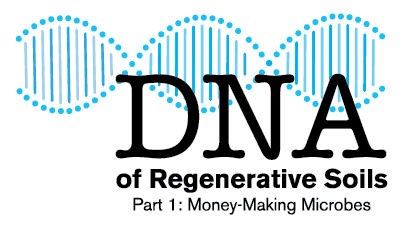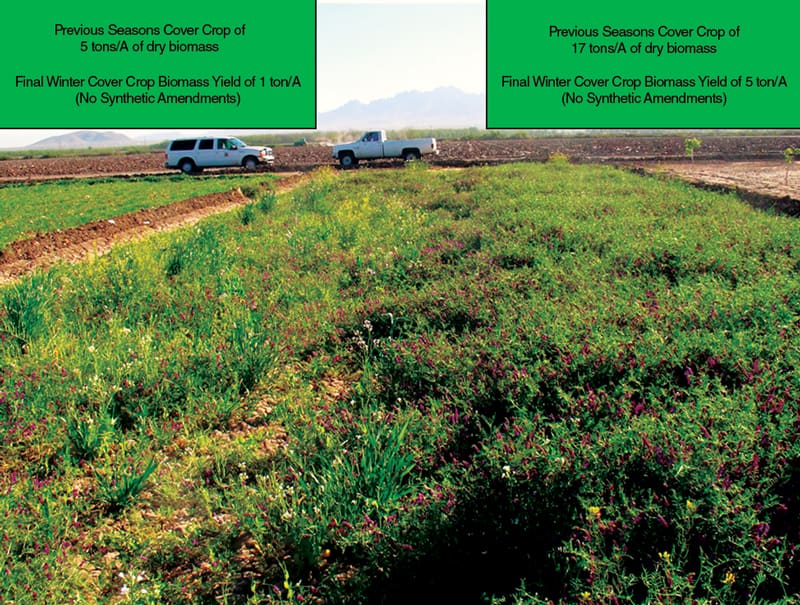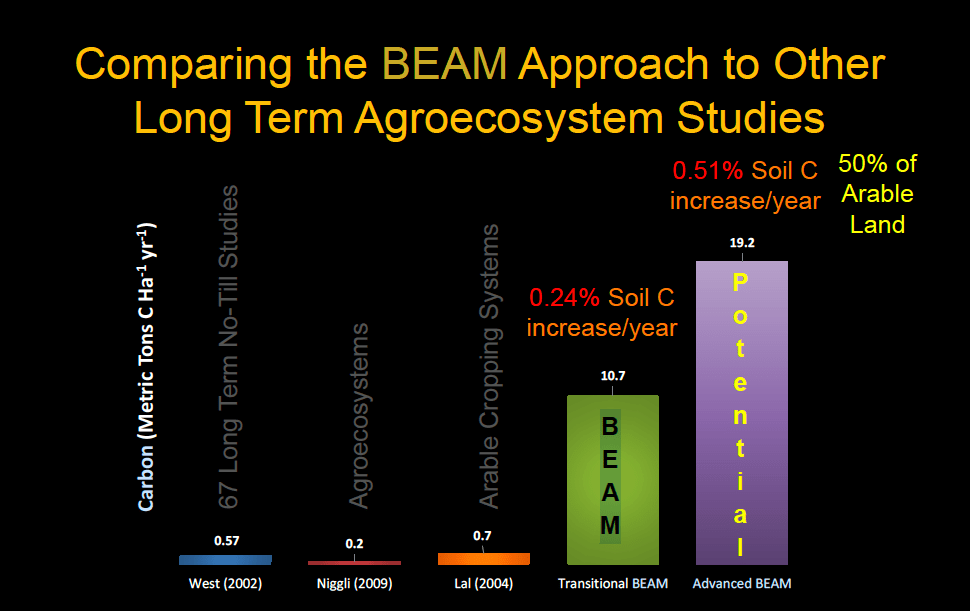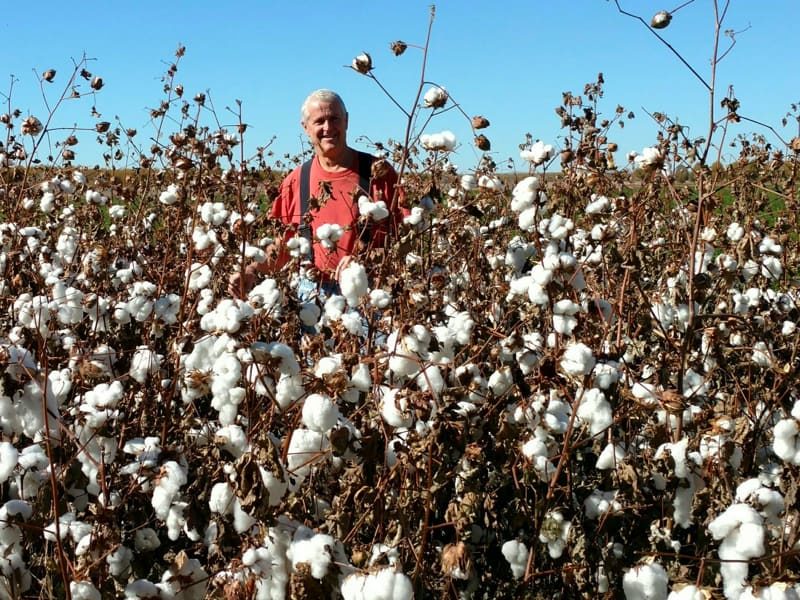
Editor’s note: This is the first of a four-article series on the components of regenerative soils that can help no-tillers and strip-tillers be more profitable.
The challenge ahead for farmers is to produce more food on a declining land area, with soils and ecosystems that are continually being degraded — all while using less water, energy and natural resources under difficult economic circumstances.
But the good news is that there are tools growers can use to meet these challenges, says David Johnson. The New Mexico State University soil researcher told 250 farmers at the Regenerative Agriculture Conference in Brandon, Manitoba, that it’s going to require a very different agricultural system than what exists today.
“We can rebuild degraded soils. We can increase soil fertility. We can produce more nutrient-dense food and forage. We can use less water to grow crops and increase both plant-water use efficiency and soil-water storage capacity. We can reduce energy use by allowing nature to extract or fix essential nutrients. We can reduce both agrichemical pollution and atmospheric CO2 at the same time.
“But most importantly, we can improve productivity and profitability,” he says.
The BEAM System
Johnson maintains that conventional agriculture over the last 70 years has damaged the microbial community structure in soils and farmers need to bring it back if they want farm ground to remain productive.
Johnson has spent the past 14 years learning what the thousands of microbes present in a well-functioning soil system actually do, and how they interact with each other and work together to maintain the system.
His journey began with a project to develop a better process to compost dairy manure and reduce its salinity. Johnson’s new composting process produced a fungal-dominant, biologically diverse compost. It was the impact of that compost on plants and soil that made Johnson realize that soils can be regenerated quickly and cost effectively by using biology.

MORE BIOMASS. In this New Mexico field, the previous season’s cover crop with no BEAM application produced 5 tons per acre of dry biomass and a final winter biomass yield of 1 ton an acre, says soil researcher David Johnson. Cover crops that received BEAM applications for 1 year produced 17 tons of dry biomass an acre and winter biomass yield of 5 tons an acre. No synthetic amendments were applied in either case.
After 1 year of the composting process, the microbial community had quadrupled and the composition of the microbes changed. After doing greenhouse tests using the compost inoculant compared to a control with no compost, Johnson found that the inoculated plants had double the growth, even though the inoculated soils had low availability of nitrogen (N), phosphorus (P) and potassium (K).
He says there was a direct correlation between plant growth and organic matter, which was higher in the inoculated soils. Organic matter is the energy resource for the thousands of microbes that each make different, but essential contributions to healthy, productive soil.
The fungal-to-bacterial ratio was higher in the inoculated soil and Johnson realized the plants grew better in a fungal-dominant soil.
Johnson experimented with different fungal-to-bacterial ratios and carbon content and found that in a low-bacterial, low-carbon system only 3% of the photosynthetic energy captured by the plant went into growth.
“For a plant to sacrifice 97% of the energy it captures and pump it into the soil, there’s got to be a reason,” Johnson says. As he increased the fungal ratio and carbon content in the mix, the flow of energy into the plant increased up to 56%.
Johnson says most agricultural soils are bacterial dominant with low carbon content and are only around 11% efficient when it comes to the energy plants use. He developed a Biologically Enhanced Agricultural Management (BEAM) system using his compost inoculant to jump start soil biology and increase biomass production.
After testing BEAM in degraded agricultural and extreme desert soils, he believes he’s shown a shift to a fungal dominant, high-carbon system can increase crop or forage production five-fold.
Even if producers don’t use an inoculant, they can still use cover crops and see great benefits to the soil, but by adding soil biology through a high-quality compost inoculant, they can speed up the process significantly.
Multi-Tasking Microbes
Johnson has learned a lot about soil biology and the function of microbes in the soil. During his research he analyzed around 2,750 species of microbes and 193 showed an actual linear correlation to plant growth.
These microbes had different functions: N fixation and N cycling, carbon cycling, metal oxidation, P solubilizing, antibiotic/antimicrobial production, biofilm and quorum sensing, CO oxidation, the ability to degrade pesticides and phytohormone production.
Essential to making the system function are free-living and symbiotic N-fixing microbes, and others that both cycle N and degrade N. “It’s important these elements are cycled in this system,” Johnson says. “It’s like money: if we don’t have a certain velocity through our economy, everything shuts down.”
Johnson maintains that due to the amount of P fertilizer growers have been applying for decades there’s a 40-year supply in agricultural soils that isn’t accessible without the specific microbes that solubilize it so the plants can use it.
Microbes responsible for metal oxidation make just about every element — including iron, aluminum, manganese, chromium and boron — plant available, and other microbes produce antibiotics and antimicrobials in the soil to help protect plant health.
Johnson identified 34 microbes as having the capability to degrade pesticides. “For almost every chemical we have applied out there we have a microbe that can break it down,” he said. “That’s critical to restoring fertility back to our systems.”
Some microbes secrete hormones that increase plant growth, and others engage in quorum sensing — a chemical communication system between multi-species bacteria that come together as a community and can express genes better than they can as a single organism.
“We see quorum sensing of 6 to 10 times more expression level so as we bring the biology back you start getting metabolic functions in this system that you won’t see when all these microbes work as a single unit,” said Johnson. “This is a synergy of systems between the plants and the microbes. They’re all interested in the same thing — survival — and they all work together.”
Microbes will even take care of food safety by reducing pathogens in the soil that are harmful to human health, such as e-coli. “When you bring back the health of the system, you can bring back competitive inhibition,” he says. “We have most every microbe that can cause disease in us, but we have competitive inhibition. Other microbes on our skin protect us.”
Another important detail Johnson discovered is the first 1% increase in soil carbon also quintupled the amount of water the soil could store.
“The more carbon you give, the more water you can store, the more efficient your system can become,” he says, noting the importance of this because it provides crops more resilience to droughts and helps mitigate floods, as well as benefitting society by preventing off-site pollution from nitrates leaching into watersheds.
Unlocking Nutrients
Because growers are used to thinking in a linear way, Johnson says it’s hard to wrap their minds around the complex, dynamic systems that are happening in soils.
A functioning system is not only about bacteria and fungi, but also viruses that are just as critical to the system, he says. Around 800 million viruses fall onto every square meter of the planet surface every day, and in oceans 20% of the bacteria is attacked by viruses and cycled into the system. Without them, Johnson says, the ocean food chain collapses.
In his research, Johnson found the nutritional value of BEAM soils is greatly increased. In the first 20 months, Johnson saw huge increases (40-1,110%) in the availability of micronutrients like manganese, iron, magnesium, calcium, zinc and copper.
The macronutrient levels went up, too, with increases of 107% in N, 64% in P and 37% in K. “That’s in a system where we only inoculated (with compost) once and didn’t use any fertilizers,” he says. “We use biology and we’re just growing plants and putting more exudates into the soil to feed these microbes.”
But what’s most important to most farmers is productivity and profitability. So how much can soil biology improve these critical factors?
Comparing BEAM to a conventional system, fertilized with 180 pounds N per acre, the BEAM approach provided a 114% increase in cotton production, Johnson found, and gave twice the plant growth of the conventional system after 1½ years. By the seventh year, the cotton plants were 6 feet high and produced 5 bales per acre in a region that averages 2.5 bales per acre, and 3,300 pounds of seed — providing a gross value of $2,000 per acre.
Better Soil, Better Yields
David Montgomery, author of Dirt: The Erosion of Civilizations, wrote his new book, Growing a Revolution: Bringing Our Soil Back to Life, after taking 6 months off from teaching geology at the University of Washington to seek out farmers who are employing regenerative agricultural practices all over the world — from subsistence farmers in Africa to large-scale soybean and corn growers in South Dakota.
In all cases, he learned they follow three simple principles to build soils and make them healthier and more productive: disturb the soil as little as possible, maintain permanent ground cover and have a diverse mix of plants.
He also found that farmers using these principles could build soil much faster than he thought, as a geologist, was possible.
“The practices that farmers used varied region to region, but they all adhered to those three basic principles of conservation agriculture, which together work to boost soil organic matter, soil life and crop health and maintain yields at the same time,” Montgomery told attendees at the Regenerative Agriculture Conference. “They were matching the conventional yields of their neighbors, but they were using far less fertilizers and chemical inputs.”
Dakota Lakes Research Farm, run through South Dakota State University near Pierre, S.D., is a farming cooperative owned by 500 farmers, and it works with farmers that operate up to 20,000 acres.
“By applying no-till, cover crops and complex rotations these farmers reduced their diesel, fertilizer and pesticide use by half,” Montgomery says. “Their yields went up once they rebuilt organic matter, and they spend less on inputs to do it. That’s a recipe for a more profitable farm.”
Lessons from Africa
But could this kind of regenerative agriculture work for all farmers? To find out, he went to Africa to meet Kofi Boa, who runs the No-Till Research Centre near Kumasi, Ghana.
After going to the U.S. to learn about no-till agriculture a few decades ago, Boa went back to his native village to teach them how to replace their slash-and-burn style of agriculture with no-till practices and cover crop seeding.
Farms in the region are family run, growing enough to feed themselves in small plots of land, he says. Traditional native farming practice was to slash and burn an area of forest, plant it for a couple of years and move on to a new plot once the nutrients were exhausted.

MORE CARBON. Soil researcher David Johnson says using the BEAM approach to boosting soil health — whether in transitional or advanced stages — resulted in bigger increases in soil carbon annually than carbon levels found in arable cropping, agroecosystems or even long-term no-till plots.
Eventually the population grew to the point where there was no new land, so repeating the practice on the same piece of land has burned away all the nutrients and the land never recovers, Montgomery says.
Boa taught the farmers the concept of no-till with cover crops and to have 6 or more different crops growing in a field at the same time, which they can do because they manually harvest.
The result? It cut soil erosion by a factor of 20, their corn yields tripled and their cowpea yields doubled — all with no additional inputs and no more fertilizer or herbicide, he says.
“They achieved this by a change in how they thought about their soil, how they approached the act of farming,” Montgomery says. “The farmers in the village now own their own farms. When Kofi started, they all rented. It was transformative.”
Money in Your Pocket
David Brandt considers himself a microbe-rancher. On his farm near Caroll, Ohio, Brandt grows corn, soybeans and wheat but he also seeds cover crops, some a mix of 10 or 12 different plant species.
It’s helped him to increase yields, save money on inputs and avoid the serious issues his neighbors are having with glyphosate resistant weeds.
Brandt has been no-tilling for 44 years, and added cover crops 20 years ago. On average, he’s only adding 24 pounds of N and using 1 quart of glyphosate per acre for a corn crop, and in 2015 — when Montgomery visited him — he was spending $320 an acre to grow 180-bushel corn and making $400 an acre profit on $4 corn.
By contrast, Brandt related that the Carroll County average, using 200 pounds an acre of N and 2.5 quarts of glyphosate per acre cost $500 an acre to grow a 100-bushel corn crop at a loss of $100 an acre at the same market price.
The trick, Montgomery says, was rebuilding soil fertility: in his clay soils, organic matter content is up to 8%.
“He increased the soil-carbon content of his land to higher than the native soil and he did it through intensive agriculture,” Montgomery says. “If the short-term economics of regenerative farming are starting to line up, the style that David’s doing is paying off well relative to his neighbors. That’s the sign of an idea that might start to catch on and spread.”
Ramping Up with Livestock
Longtime Bismarck, N.D., no-tiller Gabe Brown added another dimension to regenerative agriculture by integrating livestock and regenerative grazing practices, which he’s using to restore native prairie, as well as boost his cropping system.
Through intensive rotational grazing, using high stock densities and frequent moves that simulate the way buffalo once grazed the plains, Brown stimulates the root system of grasses to put out more exudates that feed the soil biology and build carbon.
He’s also growing mixed species of cover crops (or polycrops) that he allows his cows to graze to help cycle nutrients back into the soil.
Rather than terminating the cover crop through winter kill or spraying it with a herbicide, Brown lets the cows graze it, turning it into beef. The cows function as self-propelled methane digesters and they convert the standing biomass into manure, a nutrient source more readily taken up by plants.
“They’re basically making and distributing fertilizer out of the cover crops,” Montgomery says.
When Gabe first bought his farm, soil organic matter was 2-3% and after 20 years of experimenting and building soil carbon it’s up to around 6%. In his market garden, where he grazes cattle and added other materials like wood chips to the soil, it’s up to 11%.
“This is doable. And to a geologist, being able to do this in 10-20 years is like a snap of the finger. That is like overnight compared to the history of soil degradation,” Montgomery says. “I don’t think you necessarily need livestock to restore land, but I do believe if you manage it right it can be a great accelerator to the process of restoring land.”
This article is the first in a series looking at how regenerative soils can help no-tillers and strip-tillers be more profitable. For parts 1, 2 & 3, click on the article below:
Part 1 In-Depth: The Money-Making Power of Soil Microbes
Learn how to accelerate productivity by focusing on soil health.
Part 2 Putting Quorum Sensing to Work in Your No-Tilled Soils
Discover how soil microbes work together and make decisions.
Part 3 Crunching Data on Regenerative Farm Management
Explore the economics of running a regenerative farm operation.







Post a comment
Report Abusive Comment